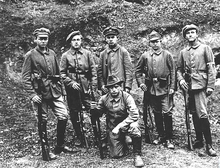
Back الانتفاضات السيليزية Arabic Силезийски въстания Bulgarian Hornoslezská povstání Czech Gwrthryfeloedd Silesia Welsh Aufstände in Oberschlesien German Sileziaj ribeloj Esperanto Levantamientos de Silesia Spanish شورشهای سیلزی Persian Sleesian kansannousut Finnish Insurrections de Silésie French
| Silesian Uprisings | |||||||||
|---|---|---|---|---|---|---|---|---|---|
| Part of the aftermath of World War I | |||||||||
 Silesian insurgents | |||||||||
| |||||||||
| Belligerents | |||||||||
|
Polish insurgents Supported by: |
| ||||||||

The Silesian Uprisings (Polish: Powstania śląskie; German: Aufstände in Oberschlesien, Polenaufstände) were a series of three uprisings from August 1919 to July 1921 in Upper Silesia, which was part of the Weimar Republic at the time. Ethnic Polish and Polish-Silesian insurrectionists, seeking to have the area transferred to the newly founded Polish Republic, fought German police and paramilitary forces which sought to keep the area part of the new German state founded after World War I. Following the conflict, the area was divided between the two countries. The rebellions have subsequently been commemorated in modern Poland as an example of Polish nationalism. Despite central government involvement in the conflict, Polish historiography renders the events as uprisings reflecting the will of ordinary Upper Silesians rather than a war.[a]
- ^ (in Polish) Ostatnie chwile odlewni Woźniaków Archived 28 September 2007 at the Wayback Machine. Zaglebie.info
- ^ Polak-Springer 2015, p. 29-30.
Cite error: There are <ref group=lower-alpha> tags or {{efn}} templates on this page, but the references will not show without a {{reflist|group=lower-alpha}} template or {{notelist}} template (see the help page).
© MMXXIII Rich X Search. We shall prevail. All rights reserved. Rich X Search